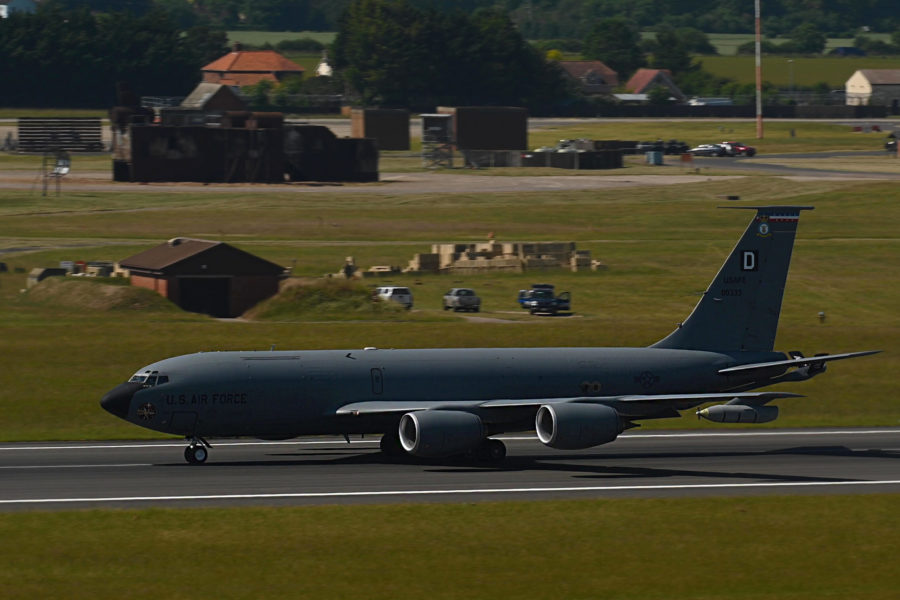RAF MILDENHALL, U.K.—Only a few years ago, RAF Mildenhall, one of a few bases in the United Kingdom that still hosts U.S. Air Force units, was set to close, a target of the 2015 European Infrastructure Consolidation Plan.
That changed in the summer of 2020, when then-Defense Secretary Mark T. Esper announced that the base, home to the 100th Air Refueling Wing, the 352nd Special Operations Wing, and several more squadrons, would remain open, saying it made “obvious strategic sense.”
Now, with its future seemingly secure, officials at Mildenhall are starting to consider how that future might look.
“I’m optimistic about the future because … I feel like we’re at a point here where we’re ultimately able to build out the future of the installation itself, making strategic investments in the actual infrastructure and necessary adjustments,” Col. Gene A. Jacobus, commander of the 100th ARW and the base commander, told Air Force Magazine.
The initial 2015 plan was for the 100th ARW—the only permanently based aerial refueling wing for U.S. Air Forces in Europe-Air Forces Africa—to transfer to Spangdahlem Air Base in Germany.
But Jacobus, who took command in July 2021 and noted that he wasn’t involved in the decision to keep Mildenhall open, said he believed the base’s strategic value remains strong.
“The unique capability that we provide from this installation—we talk about it being a strategic forward base—is, I think, key to ultimately its relevance in this AOR and the positioning of the installation—where it’s at in the theater, where we can range from in the KC-135 from here, its close proximity to other U.S. visiting forces, i.e. RAF Lakenheath, and the capability it has there,” Jacobus said.
Indeed, Lakenheath and its squadrons of F-15Es and F-35s sit just a few miles from Mildenhall, and the two bases continue to work together “quite extensively,” Jacobus said.
“We’re proud of the capability that they bring to this AOR, and we’re proud of the fact that we can help extend that capability, wherever it needs to be, at a moment’s notice,” he said.
In recent years, Lakenheath has seen some notable changes, with construction of a new flight simulator facility, maintenance unit, hangars, storage facilities, and more in advance of the arrival of new F-35 fighters this past December.
Now, Jacobus and other leaders at Mildenhall are considering how it, too, might change and grow in the coming years.
“My view is that we will continue to look at not only today’s capabilities, but what should tomorrow look like, in terms of infrastructure to meet future mission needs,” Jacobus said.
Those considerations are still in early stages, but Jacobus hinted that changes could go beyond simply modernizing a base that was first constructed in the 1930s.
“There are areas on the installation that we want to focus our attention on essentially updating the infrastructure itself, but also looking at, are there changes necessary to the base for a future mission?” Jacobus said. “So we don’t have it formalized yet. But we’re certainly putting together a plan, and we’ll look to resource against the plan once we get it finalized.”
Jacobus declined to share any details on what that plan might look like, but he did say that the action group tasked with helping to draft the plan have started with a fundamental consideration: “What is that future mission?”
“We’re less than two years out from the decision to reverse the closure,” Jacobus said. “So there’s still work to be done there. And we’re certainly getting after it.”
Considerations of the future mission raise further questions about the fleet of 15 KC-135s operated by the 100th ARW. The legacy tanker has been flying for more than 60 years, and the Air Force has sought to cut the fleet in recent years, requesting to retire 13 jets in 2021, 18 in 2022, and 13 in 2023.
“We are proud of the ‘135, and I know that there’s a lot of discussion about the future of the ‘135,” Jacobus said. “But what I can tell you is that every single day … we’re producing KC-135 sorties and providing air refueling at the speed of relevance across this AOR. And so, you know, going out into the future, and again, outside of really my purview, but we’re receiving the support from our higher headquarters, through the supply chain, through the logistics professionals, to continue to produce sorties.”
As the airframes continue to age, though, more issues will arise, Jacobus acknowledged. And looking to get ahead of that, “we’re thinking through … what are those potential future needs so that we can anticipate any concerns that might be in the future,” he said.
Meanwhile, the KC-135’s ostensible replacement, the KC-46, still has not been cleared for combat operations, and only recently refueled its first international aircraft as issues persist with its Remote Vision System and other aspects.
So as Mildenhall’s planning for the future unfolds, it’s doing so under the assumption that the KC-135 will be sticking around for some time to come, Jacobus said.
“What I tell our team is we will keep leaning into the KC-135 until we’re directed otherwise. And so when and if that decision comes at some point, we’ll make the necessary adjustments,” Jacobus said. “But we’re certainly proud to continue to fly such a historic aircraft that has continued to produce amazing capabilities.”

